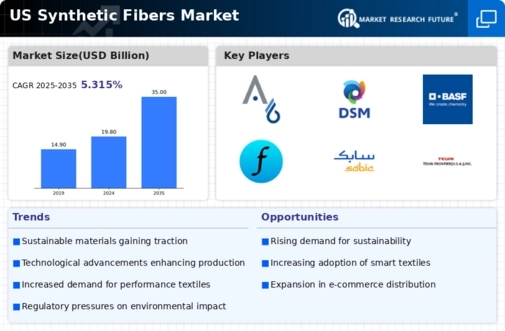The synthetic fibers market is characterized by a dynamic competitive landscape, driven by innovation, sustainability, and technological advancements. Key players such as Invista (US), DuPont (US), and BASF (US) are at the forefront, each adopting distinct strategies to enhance their market positioning. Invista (US) focuses on innovation in fiber technology, particularly in developing sustainable solutions that cater to the growing demand for eco-friendly products. DuPont (US), on the other hand, emphasizes strategic partnerships and collaborations to expand its product offerings and enhance its research capabilities. BASF (US) is actively pursuing digital transformation initiatives, aiming to optimize its operations and improve supply chain efficiency. Collectively, these strategies contribute to a competitive environment that is increasingly centered around sustainability and technological advancement.
In terms of business tactics, companies are localizing manufacturing and optimizing supply chains to enhance responsiveness to market demands. The competitive structure of the synthetic fibers market appears moderately fragmented, with several key players exerting influence. This fragmentation allows for a diverse range of products and innovations, although it also intensifies competition among established and emerging firms.
In November 2025, Invista (US) announced the launch of a new line of bio-based fibers, which are derived from renewable resources. This strategic move not only aligns with the growing consumer preference for sustainable products but also positions Invista (US) as a leader in eco-friendly fiber technology. The introduction of these fibers is expected to enhance the company's market share and appeal to environmentally conscious consumers.
In October 2025, DuPont (US) entered into a strategic partnership with a leading textile manufacturer to co-develop advanced synthetic fibers that incorporate smart technology. This collaboration is significant as it allows DuPont (US) to leverage its expertise in materials science while tapping into the textile manufacturer's market reach. The integration of smart technology into synthetic fibers could potentially revolutionize the industry, offering enhanced functionality and performance.
In September 2025, BASF (US) unveiled a new digital platform aimed at streamlining its supply chain processes. This initiative is crucial as it enhances transparency and efficiency, allowing BASF (US) to respond more swiftly to market changes. The digitalization of supply chain operations is likely to provide a competitive edge, enabling the company to better meet customer demands and reduce operational costs.
As of December 2025, current competitive trends in the synthetic fibers market are heavily influenced by digitalization, sustainability, and the integration of artificial intelligence (AI). Strategic alliances are increasingly shaping the landscape, fostering innovation and collaboration among key players. Looking ahead, competitive differentiation is expected to evolve, with a notable shift from price-based competition to a focus on innovation, technology, and supply chain reliability. Companies that prioritize these aspects are likely to gain a substantial advantage in the market.



















Leave a Comment